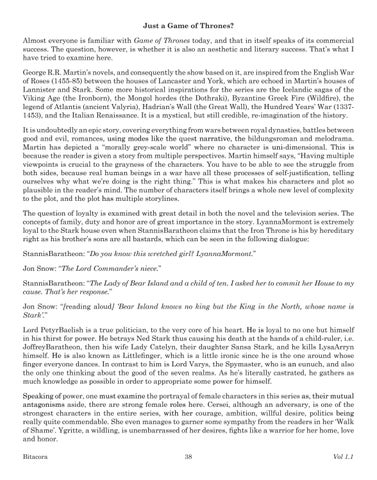Just a Game of Thrones? Almost everyone is familiar with Game of Thrones today, and that in itself speaks of its commercial success. The question, however, is whether it is also an aesthetic and literary success. That’s what I have tried to examine here. George R.R. Martin’s novels, and consequently the show based on it, are inspired from the English War of Roses (1455-85) between the houses of Lancaster and York, which are echoed in Martin’s houses of Lannister and Stark. Some more historical inspirations for the series are the Icelandic sagas of the Viking Age (the Ironborn), the Mongol hordes (the Dothraki), Byzantine Greek Fire (Wildfire), the legend of Atlantis (ancient Valyria), Hadrian’s Wall (the Great Wall), the Hundred Years’ War (13371453), and the Italian Renaissance. It is a mystical, but still credible, re-imagination of the history. It is undoubtedly an epic story, covering everything from wars between royal dynasties, battles between good and evil, romances, using modes like the quest narrative, the bildungsroman and melodrama. Martin has depicted a “morally grey-scale world” where no character is uni-dimensional. This is because the reader is given a story from multiple perspectives. Martin himself says, “Having multiple viewpoints is crucial to the grayness of the characters. You have to be able to see the struggle from both sides, because real human beings in a war have all these processes of self-justification, telling ourselves why what we’re doing is the right thing.” This is what makes his characters and plot so plausible in the reader’s mind. The number of characters itself brings a whole new level of complexity to the plot, and the plot has multiple storylines. The question of loyalty is examined with great detail in both the novel and the television series. The concepts of family, duty and honor are of great importance in the story. LyannaMormont is extremely loyal to the Stark house even when StannisBaratheon claims that the Iron Throne is his by hereditary right as his brother’s sons are all bastards, which can be seen in the following dialogue: StannisBaratheon: “Do you know this wretched girl? LyannaMormont.” Jon Snow: “The Lord Commander’s niece.” StannisBaratheon: “The Lady of Bear Island and a child of ten. I asked her to commit her House to my cause. That’s her response.” Jon Snow: “[reading aloud] ‘Bear Island knows no king but the King in the North, whose name is Stark’.” Lord PetyrBaelish is a true politician, to the very core of his heart. He is loyal to no one but himself in his thirst for power. He betrays Ned Stark thus causing his death at the hands of a child-ruler, i.e. JoffreyBaratheon, then his wife Lady Catelyn, their daughter Sansa Stark, and he kills LysaArryn himself. He is also known as Littlefinger, which is a little ironic since he is the one around whose finger everyone dances. In contrast to him is Lord Varys, the Spymaster, who is an eunuch, and also the only one thinking about the good of the seven realms. As he’s literally castrated, he gathers as much knowledge as possible in order to appropriate some power for himself. Speaking of power, one must examine the portrayal of female characters in this series as, their mutual antagonisms aside, there are strong female roles here. Cersei, although an adversary, is one of the strongest characters in the entire series, with her courage, ambition, willful desire, politics being really quite commendable. She even manages to garner some sympathy from the readers in her ‘Walk of Shame’. Ygritte, a wildling, is unembarrassed of her desires, fights like a warrior for her home, love and honor. Bitacora
38
Vol 1.1


